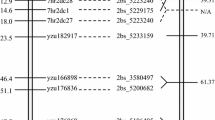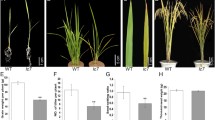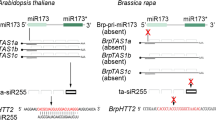Abstract
Key message
Identification and mapping of an inhibitor of Ndhrl1 mediating nitrogen-dependent hypersensitive reaction-like phenotype in wheat.
Abstract
Hypersensitive reaction-like (HRL) traits are characteristic of spontaneous lesions including yellowish spots, brown spots or white-stripe that appeared randomly and dispersedly on all the leaves in the absence of plant pathogens. Our previous studies have shown that the wheat line P7001 showed an HRL trait at low nitrogen supply, and this trait was controlled by the gene Ndhrl1 (Nitrogen-dependent hypersensitive reaction-like 1). In order to investigate the robustness of the trait expression mediated by Ndhrl1 under different genetic backgrounds, seven genetic populations, with P7001 being the common female parent, were constructed and analyzed. F1 plants from six of the seven combinations showed HRL trait and Ndhrl1 segregated in a dominant way of HRL: non-HRL = 3:1 in the six populations (F2). Exceptionally, the F1 plants of P7001/Fielder combination showed non-HRL trait and HRL trait in the F2 population showed a contrasting recessive segregation ratio of HRL: non-HRL = 1:3, suggesting Fielder may have another HRL-related gene. Using 55 K SNP array and PCR-based markers, the HRL-related gene in Fielder was mapped to an interval of 5.63–12.91 Mb on the short arm of chromosome 2B with the flanking markers Yzu660R075552 and Yzu660F075941. A recombinant with genomic region of Fielder at Ndhrl1 locus showing HRL trait demonstrated that Fielder also harbored Ndhrl1 same as P7001. Thus, Fielder carries a single dominant suppressor of Ndhrl1, designated as Ihrl1 (Inhibitor of hypersensitive reaction-like). Interestingly, Ihrl1 is tightly linked to Ndhrl1 and may be also involved in nitrogen metabolic and (or) signaling pathways.


Similar content being viewed by others
Data availability
The data sets generated and analyzed in this study are available upon reasonable request from the corresponding authors.
References
Ali S, Mir ZA, Tyagi A, Mehari H, Meena RP, Bhat JA, Yadav P, Papalou P, Rawat S, Grover A (2017) Overexpression of NPR1 in Brassica juncea Confers Broad Spectrum Resistance to Fungal Pathogens. Front Plant Sci 8:1693
Arase S, Fujita K, Uehara T, Honda Y, Isota J (2000) Light-Enhanced Resistance to Magnaporthe grisea Infection in the Rice Sekiguchi Lesion Mutants. J Plant Physiol 148:197–203
Bruggeman Q, Raynaud C, Benhamed M, Delarue M (2015) To die or not to die? Lessons from lesion mimic mutants. Front Plant Sci 6:24
Coll NS, Epple P, Dangl JL (2011) Programmed cell death in the plant immune system. Cell Death Differ 18:1247–1256
Colombatti F, Gonzalez DH, Welchen E (2014) Plant mitochondria under pathogen attack: A sigh of relief or a last breath? Mitochondrion 19:238–244
Cui Y, Peng Y, Zhang Q, Xia S, Ruan B, Xu Q, Yu X, Zhou T, Liu H, Zeng D, Zhang G, Gao Z, Hu J, Zhu L, Shen L, Guo L, Qian Q, Ren D (2021) Disruption of EARLY LESION LEAF 1, encoding a cytochrome P450 monooxygenase, induces ROS accumulation and cell death in rice. Plant J 105:942–956
Fan J, Bai P, Ning Y, Wang J, Shi X, Xiong Y, Zhang K, He F, Zhang C, Wang R, Meng X, Zhou J, Wang M, Shirsekar G, Park CH, Bellizzi M, Liu W, Jeon J-S, Xia Y, Shan L, Wang G-L (2018) The Monocot-Specific Receptor-like Kinase SDS2 Controls Cell Death and Immunity in Rice. Cell Host Microbe 23:498-510.e495
Ishikawa A, Okamoto H, Iwasaki Y, Asahi T (2001) A deficiency of coproporphyrinogen III oxidase causes lesion formation in Arabidopsis. Plant J 27:89–99
Jiang C-J, Shimono M, Maeda S, Inoue H, Mori M, Hasegawa M, Sugano S, Takatsuji H (2009) Suppression of the Rice Fatty-Acid Desaturase Gene OsSSI2 Enhances Resistance to Blast and Leaf Blight Diseases in Rice. Mol Plant Microbe Interact 22:820–829
Johnson C, Boden E, Arias J (2003) Salicylic Acid and NPR1 Induce the Recruitment of trans-Activating TGA Factors to a Defense Gene Promoter in Arabidopsis. Plant Cell 15:1846–1858
Johnson R (1981) Durable resistance: definition of, genetic control, and attainment in plant breeding. Phytopathology 71:567–568
Kang SG, Lee KE, Singh M, Kumar P, Matin MN (2021) Rice Lesion Mimic Mutants (LMM): The Current Understanding of Genetic Mutations in the Failure of ROS Scavenging during Lesion Formation. Plants (basel) 10:1598
Kojo K, Yaeno T, Kusumi K, Matsumura H, Fujisawa S, Terauchi R, Iba K (2006) Regulatory Mechanisms of ROI Generation are Affected by Rice spl Mutations. Plant Cell Physiol 47:1035–1044
Li C, Liu H, Wang J, Pan Q, Wang Y, Wu K, Jia P, Mu Y, Tang H, Xu Q, Jiang Q, Liu Y, Qi P, Zhang X, Huang L, Chen G, Wang J, Wei Y, Zheng Y, Gou L, Yao Q, Lan X, Ma J (2021) Characterization and fine mapping of a lesion mimic mutant (Lm5) with enhanced stripe rust and powdery mildew resistance in bread wheat (Triticum aestivum L.). Theor Appl Genet https://doi.org/10.1007/s00122-021-03973-1
Li L, Liu J, Xue X, Li C, Yang Z, Li T (2018) CAPS/dCAPS Designer: a web-based high-throughput dCAPS marker design tool. Sci China Life Sci 61:992–995
Li L, Shi X, Zheng F, Li CC, Wu D, Bai GH, Gao DR, Wu JC, Li T (2016) A novel nitrogen-dependent gene associates with the lesion mimic trait in wheat. Theor Appl Genet 129:2075–2084
Li L, Sun F, Wu D, Zhen F, Bai G, Gao D, Li T (2017) High-throughput development of genome-wide locus-specific informative SSR markers in wheat. Sci China Life Sci 60:671–673
Li T, Bai G (2009) Lesion mimic associates with adult plant resistance to leaf rust infection in wheat. Theor Appl Genet 119:13–21
Li T, Bai G, Gu S (2012) A combination of leaf rust resistance gene Lr34 and lesion mimic gene lm significantly enhances adult plant resistance to Puccinia triticina in wheat. Chin Sci Bull 57:2113–2119
Liu R, Lu J, Zheng S, Du M, Zhang C, Wang M, Li Y, Xing J, Wu Y, Zhang L (2021) Molecular mapping of a novel lesion mimic gene (lm4) associated with enhanced resistance to stripe rust in bread wheat. BMC Genom Data 22:1
Lorrain S, Vailleau F, Balagué C, Roby D (2003) Lesion mimic mutants: keys for deciphering cell death and defense pathways in plants? Trends Plant Sci 8:263–271
Moeder W, Yoshioka K (2008) Lesion mimic mutants: a classical, yet still fundamental approach to study programmed cell death. Plant Signal Behav 3:764–767
Noutoshi Y, Ito T, Seki M, Nakashita H, Yoshida S, Marco Y, Shirasu K, Shinozaki K (2005) A single amino acid insertion in the WRKY domain of the Arabidopsis TIR-NBS-LRR-WRKY-type disease resistance protein SLH1 (sensitive to low humidity 1) causes activation of defense responses and hypersensitive cell death. Plant J 43:873–888
Porebski S, Bailey LG, Baum BR (1997) Modification of a CTAB DNA extraction protocol for plants containing high polysaccharide and polyphenol components. Plant Mol Biol Rep 15:8–15
Qiu T, Zhao X, Feng H, Qi L, Yang J, Peng Y-L, Zhao W (2021) OsNBL3, a mitochondrion-localized pentatricopeptide repeat protein, is involved in splicing nad5 intron 4 and its disruption causes lesion mimic phenotype with enhanced resistance to biotic and abiotic stresses. Plant Biotechnol J 19:2277–2290
Shi M, Wang Z, Ma Z, Song W, Lu W, Xiao K (2020) Characterization on TaMPK14, an MAPK family gene of wheat, in modulating N-starvation response through regulating N uptake and ROS homeostasis. Plant Cell Rep 39:1285–1299
Shirsekar GS, Vega-Sanchez ME, Bordeos A, Baraoidan M, Swisshelm A, Fan J, Park CH, Leung H, Wang G-L (2014) Identification and Characterization of Suppressor Mutants of spl11-Mediated Cell Death in Rice. Mol Plant Microbe Interact 27:528–536
Sohn KH, Segonzac C, Rallapalli G, Sarris PF, Woo JY, Williams SJ, Newman TE, Paek KH, Kobe B, Jones JDG (2014) The Nuclear Immune Receptor RPS4 Is Required for RRS1SLH1-Dependent Constitutive Defense Activation in Arabidopsis thaliana. PLoS Genet 10:e1004655
Straus MR, Rietz S, Loren V, van Themaat E, Bartsch M, Parker JE (2010) Salicylic acid antagonism of EDS1-driven cell death is important for immune and oxidative stress responses in Arabidopsis. Plant J 62:628–640
Sun L, Wang Y, Liu LL, Wang C, Gan T, Zhang Z, Wang Y, Wang D, Niu M, Long W, Li X, Zheng M, Jiang L, Wan J (2017) Isolation and characterization of a spotted leaf 32 mutant with early leaf senescence and enhanced defense response in rice. Sci Rep 7:41846
Tong X, Qi J, Zhu X, Mao B, Zeng L, Wang B, Li Q, Zhou G, Xu X, Lou Y, He Z (2012) The rice hydroperoxide lyase OsHPL3 functions in defense responses by modulating the oxylipin pathway. Plant J 71:763–775
Ueno M, Kihara J, Arase S (2015) Tryptamine and sakuranetin accumulation in Sekiguchi lesions associated with the light-enhanced resistance of the lesion mimic mutant of rice to Magnaporthe oryzae. J Gen Plant Pathol 81:1–4
Wang F, Wu W, Wang D, Yang W, Sun J, Liu D, Zhang A (2016) Characterization and genetic analysis of a novel light-dependent lesion mimic mutant, lm3, showing adult-plant resistance to powdery mildew in common wheat. PLoS ONE 11:e0155358
Wang J, Bayles KW (2013) Programmed cell death in plants: lessons from bacteria? Trends Plant Sci 18:133–139
Wang S-H, Lim J-H, Kim S-S, Cho S-H, Yoo S-C, Koh H-J, Sakuraba Y, Paek N-C (2015a) Mutation of SPOTTED LEAF3 (SPL3) impairs abscisic acid-responsive signalling and delays leaf senescence in rice. J Exp Bot 66:7045–7059
Wang Z, Wang Y, Hong X, Hu D, Liu C, Yang J, Li Y, Huang Y, Feng Y, Gong H, Li Y, Fang G, Tang H, Li Y (2015b) Functional inactivation of UDP-N-acetylglucosamine pyrophosphorylase 1 (UAP1) induces early leaf senescence and defence responses in rice. J Exp Bot 66:973–987
Wu C, Bordeos A, Madamba MRS, Baraoidan M, Ramos M, Wang G-l, Leach JE, Leung H (2008) Rice lesion mimic mutants with enhanced resistance to diseases. Mol Genet Genomics 279:605–619
Yao Q, Zhou R, Fu T, Wu W, Zhu Z, Li A, Jia J (2009) Characterization and mapping of complementary lesion-mimic genes lm1 and lm2 in common wheat. Theor Appl Genet 119:1005–1012
Zhang H, Xu X, Wang M, Wang H, Deng P, Zhang Y, Wang Y, Wang C, Wang Y, Ji W (2021) A dominant spotted leaf gene TaSpl1 activates endocytosis and defense-related genes causing cell death in the absence of dominant inhibitors. Plant Sci 310:110982
Zhang Z, Lenk A, Andersson MX, Gjetting T, Pedersen C, Nielsen ME, Newman M-A, Hou B-H, Somerville SC, Thordal-Christensen H (2008) A Lesion-Mimic Syntaxin Double Mutant in Arabidopsis Reveals Novel Complexity of Pathogen Defense Signaling. Mol Plant 1:510–527
Zhao J, Liu P, Li C, Wang Y, Guo L, Jiang G, Zhai W (2017) LMM5.1 and LMM5.4, two eukaryotic translation elongation factor 1A-like gene family members, negatively affect cell death and disease resistance in rice. J Genet Genom 44:107–118
Zhen X, Xu F, Zhang W, Li N, Li X (2019) Overexpression of rice gene OsATG8b confers tolerance to nitrogen starvation and increases yield and nitrogen use efficiency (NUE) in Arabidopsis. PLoS ONE 14:e0223011
Funding
This work was supported by the National Natural Science Foundation of China (31600997, 31271704) and the Priority Academic Program Development of Jiangsu Higher Education Institutions (PAPD). Any opinions, or conclusions expressed in this publication are those of the authors and do not necessarily reflect the view of the funders.
Author information
Authors and Affiliations
Contributions
LL designed the experiments, supervised all analyses and drafted the manuscript; JL co-drafted the manuscript and carried out the primer design and genotyping. HG carried out the mapping of Ndhrl1; YZ and JL carried out the mapping of Ihrl1; ZS and TL conceived the idea of the study and finalized the manuscript. All the authors read and approved the manuscript.
Corresponding author
Ethics declarations
Conflict of interest
The authors declare that they have no conflict of interest.
Ethical standards
The authors declare that the experiments comply with the current laws of the country in which they were performed.
Additional information
Communicated by Aimin Zhang.
Publisher's Note
Springer Nature remains neutral with regard to jurisdictional claims in published maps and institutional affiliations.
Supplementary Information
Below is the link to the electronic supplementary material.
122_2022_4200_MOESM1_ESM.pdf
Supplementary Figure S1. Phenotype of eight wheat varieties and seven F1 plants. Supplementary Figure S2. The genetic map of P7001/Fielder. Supplementary Table S1. Primer sequence of Indel markers (PDF 832 KB)
Rights and permissions
Springer Nature or its licensor holds exclusive rights to this article under a publishing agreement with the author(s) or other rightsholder(s); author self-archiving of the accepted manuscript version of this article is solely governed by the terms of such publishing agreement and applicable law.
About this article
Cite this article
Li, L., Liu, J., Gong, H. et al. A dominant gene Ihrl1 is tightly linked to and inhibits the gene Ndhrl1 mediating nitrogen-dependent hypersensitive reaction-like phenotype in wheat. Theor Appl Genet 135, 3563–3570 (2022). https://doi.org/10.1007/s00122-022-04200-1
Received:
Accepted:
Published:
Issue Date:
DOI: https://doi.org/10.1007/s00122-022-04200-1




